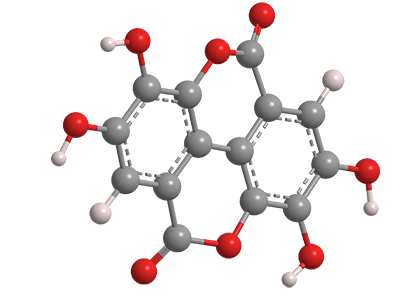What molecule am I?


Ellagic acid is a natural fused-ring polyphenol with a pKa of 5.5. It is found in fruits, nuts, the galls of oak trees, and the kino (gum) of eucalyptus trees. Its name comes from the French acide ellagique, coined from the word galle (gall) spelled backward.
Ellagic acid has been known since the first half of the 19th century as a component of tanning materials. It was mentioned in the chemical literature as early as 1868, when German chemist and industrialist Julius Löwe synthesized it by oxidizing gallic acid1 with arsenic acid or silver oxide. In 1905, Arthur George Perkin2* and Maximilian Nierenstein at the University of Leeds (UK) refined the process by using sodium persulfate as the oxidant.
Ellagic acid has been touted as a natural antioxidant and marketed as a dietary supplement with claims that it can prevent or treat cancer and heart disease. From 2008 to 2021, the US Food and Drug Administration issued warnings to drug companies and the public about false health claims about the molecule.
But ellagic acid may have some health benefits. In 2006, Juan Carlos Espin and colleagues at CEBAS−CSIC3 (Murcia, Spain) found that two colonic microflora ellagic acid metabolites (urolithins A4 and B5) have, oddly, both estrogenic and antiestrogenic activity. The authors suggested that the urolithins may have implications for treating breast cancer. Espin and his group subsequently investigated several aspects of urolithin activity, including its anti-inflammatory properties.
Fast forward to September 2022: Building on Espin’s work, Jian Zhao and co-workers at Sichuan University (Chengdu, China), used mouse studies to determine that urolithin A attenuates Helicobacter pylori-induced damage in vivo. Urolithin A not only decreased inflammation in the gut, but it also reduced H. pylori virulence factor secretion, tissue injuries, and the relative abundance of Helicobacter spp. In feces of H. pylori-infected mice.
For other findings on ellagic acid, see ScienceDirect’s information page.
1. CAS Reg. No. 149-91-7.
2. For whom the Perkin Transactions journals were named.
3. Center for Edaphology and Applied Biology of Segura, Spanish National Research Council. Edaphology is a type of soil science.
4. CAS Reg. No. 1143-70-0.
5. CAS Reg. No. 1139-83-9.
Ellagic acid hazard information
| Hazard class** | GHS code and hazard statement | |
|---|---|---|
| Acute toxicity, oral, category 4 | H302—Harmful if swallowed | |
| Skin corrosion/irritation, category 2 | H315—Causes skin irritation | |
| Serious eye damage/eye irritation, category 2A | H319—Causes serious eye irritation | |
| Specific target organ toxicity, single exposure, respiratory tract irritation, category 3 | H335—May cause respiratory irritation | |
*Compilation of multiple safety data sheets.
**Globally Harmonized System (GHS) of Classification and Labeling of Chemicals. Explanation of pictograms.
MOTW updates
Nitric oxide1 (NO) was the Molecule of the Week for February 4, 2013. It is a colorless, toxic gas that is a stable free radical and a physiological signaling molecule. This month, Ke Chu and coauthors at Lanzhou Jiaotong University (Lanzhou) and Henan University (Kaifeng, both in China) reported that NO can be electrolytically hydrogenated to ammonia on molybdenum carbide (Mo2C) nanosheets, a catalyst that selectively activates NO.
Aspartame2 was the Molecule of the Week for November 4, 2019. It is a widely used dipeptide artificial sweetener that has come under scrutiny because consuming it has been linked to increased appetite and weight gain. It may also be a public health hazard: This month, Xing-Fang Li and co-workers at the University of Alberta (Edmonton) described reactions of aspartame with residual chlorine in tap water to form chlorinated disinfection byproducts—in particular, significant amounts of potentially toxic 2,6-dichloro-1,4-benzoquinone3.
1. CAS Reg. No. 10102-43-9.
2. CAS Reg. No. 22839-47-0.
3. CAS Reg. No. 697-91-6.
This molecule was suggested by a reader. We present almost all of the molecules suggested by our readers. If you have a molecule you would like us to consider, please send us a message. And thank you for your interest in Molecule of the Week! —Ed.
Ellagic acid fast facts
| CAS Reg. No. | 476-66-4 |
| SciFinder nomenclature | [1]Benzopyrano[5,4,3-cde][1]benzopyran-5,10-dione, 2,3,7,8-tetrahydroxy- |
| Empirical formula | C14H6O8 |
| Molar mass | 302.19 g/mol |
| Appearance | Cream-colored to yellow crystals or powder |
| Melting point | >360 °C |
| Water solubility | 0.82 g/L |
MOTW update:
May 15, 2023
Ellagic acid is a natural polyphenol that was originally used in tanning agents; but more recently, it has shown potential health benefits such as treating breast cancer and gut inflammation. This month, Ruili Yang and co-workers at South China Agricultural University (Guangzhou) reported that ellagic acid, by metabolizing to urolithin A1, slows aging in rats by reducing cognitive impairment, increasing γ-aminobutyric acid and serotonin levels, and suppressing inflammatory and oxidative stress.
1. CAS Reg. No. 1143-70-0.

Learn more about this molecule from CAS, the most authoritative and comprehensive source for chemical information.
Molecule of the Week needs your suggestions!
If your favorite molecule is not in our archive, please send us a message. The molecule can be notable for its current or historical importance or for any quirky reason. Thank you!
Stay Ahead of the Chemistry Curve
Learn how ACS can help you stay ahead in the world of chemistry.

